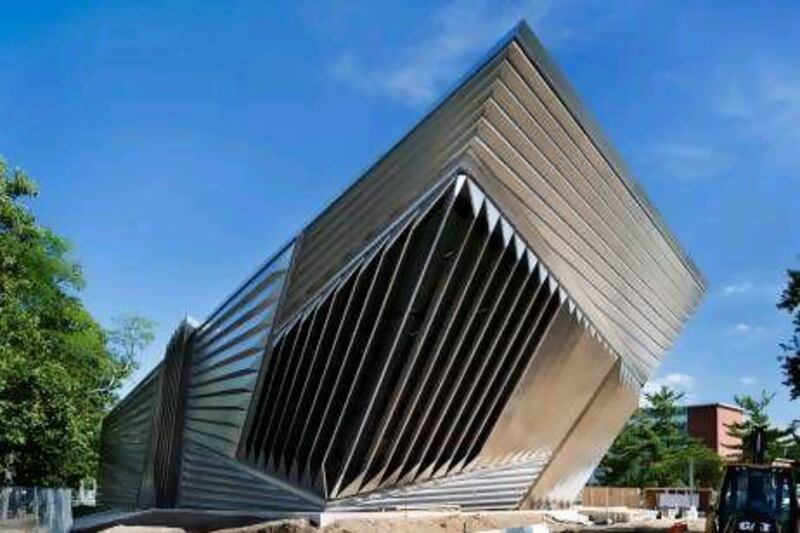Zaha Hadid's sleek Eli and Edythe Broad Art Museum in East Lansing, Michigan, is an upward vector of stainless steel that juts into the huge Michigan State University (MSU) campus. Its outer walls are pleated with industrial-sized folds in an homage to a region that once defined the US's global leadership in manufacturing.
Lacking the Baghdad-born architect's stylish signature curves, the structure seems designed to give and to sustain a jolt, an explicit rejection of the Midwest's current disparaging label, the Rust Belt.
At a relatively modest budget for Hadid, some US$45 million (Dh165m), and covering 4,000 square metres, the museum asserts a bold profile for MSU, an institution whose reputation outside the state is built on American football and basketball.
Hadid calls the project a dialogue of different geometries. "The formal composition of the Broad is derived from the landscape around it. Its stainless steel cladding appears to change constantly with different light and viewing perspectives – the directional pleats echoing the unique topography and circulation routes of the campus," she says. "Michigan's long tradition of innovation and skilled manufacturing has enabled us to deliver a building of the highest material and finish quality."
The museum's principal funder, Eli Broad, is an entrepreneur and art collector whose initial fortune came from building modestly priced homes in California. Broad, 81, an accounting graduate of MSU, has already endowed a business school and a school of management.
He gave $28m to the museum, hoping that contemporary art and a building by Hadid (the first woman to win architecture's Pritzker Prize) would lure tourists - a lofty dream in Michigan, home to a struggling automotive industry.
"People are already talking about opening galleries across the street, perhaps building an additional hotel. It will have a mini-Bilbao effect," Broad says, referring to the Spanish industrial city ravaged by separatist violence that became a tourist destination after the Guggenheim Museum Bilbao, designed by Frank Gehry, opened in 1997.
Broad speaks from experience. He helped fund the Walt Disney Concert Hall in Los Angeles, designed by Gehry. A Broad Museum in Los Angeles, under construction by the firm Diller Scofidio + Renfro, will house some of Broad's art collection, which many institutions covet. The principal cultural benefactor in Los Angeles, Broad also sits on the board of the Museum of Modern Art in New York.
"The building clearly announces the university's desire to be firmly planted in this new century, and in the next century," says Michael Rush, the Broad Museum's new director.
"It has a very futuristic patina to it," Rush notes. "The word that I keep using about it is dynamism. This building is almost literally launching toward the future.
"Most museums – the Metropolitan, the Louvre, any of our great museums – when you go into them, you feel a certain reverence. You feel a silence. You feel a magnificence," he says.
"That is not the feeling with this building. When you come into this building you feel off kilter – the windows lean toward the east or the west. The galleries are not white boxes. Once you're caught off guard like that, it heightens your perception, your attention, and your sensitivities. This is very congruent with what artists have been doing, at least since the 1960: trying to redirect our perceptions."
The museum's opening exhibition, Global Groove 1973/2012, aims to bring those artists to a new audience, which includes the US's largest concentration of Arab-Americans in the Detroit area, a short drive away. The show includes the work of the Palestinian artist Bashar Alhroub.
"It is an interesting time for Arab artists," Hadid says. "Their work has evolved with its own characteristic voice. For millennia, the arts and sciences have bridged the cultural divide between East and West, showing us these worlds are not mutually exclusive, but rather layered upon each other and profoundly interlinked."
Eli Broad, art advocate
Eli Broad (rhymes with "road") built his fortune, now valued at some US$5.8 billion (Dh21bn), on small affordable houses, but his reputation rests on grander projects. The art collector was a founder of the Museum of Contemporary Art (MoCA) in Los Angeles, now a controversial laboratory for his populist goal of expanding public interest in museums.
Broad's philanthropic footprint is all over Los Angeles and broadening – the Walt Disney Concert Hall, the Broad Center at UCLA (designed by Richard Meier) and the forthcoming Broad Museum (across from the Disney hall).
The businessman also made art market history in 1994 for buying Roy Lichtenstein's I …I'm Sorry at Sotheby's for $2.5m, which Broad charged to his American Express card, donating 2.5 million frequent flyer miles to art students.
Broad recently published a memoir, titled The Art of Being Unreasonable: Lessons in Unconventional Thinking.
Arabs in Michigan
As the state of Michigan struggles to retain its heavy industry, families are moving away. Yet Arabs are rushing in. Early immigrants (mostly Lebanese) were first attracted to Detroit and the neighbouring city of Dearborn in the 1920s by the promise of auto industry jobs.
A recent estimate puts the Arab population in and around Detroit at more than 400,000 ? a number that may be undercounted as more Egyptians and Syrians arrive.
Connecting with that community is a goal of the Broad Art Museum, says the director Michael Rush. Besides the Palestinian artist Bashar Alhroub, artists from Islamic countries including Negar Behbahani (Iran) and Basir Mahmood (Pakistan) are also represented in the museum's inaugural exhibition, Global Groove 1973/2012.





